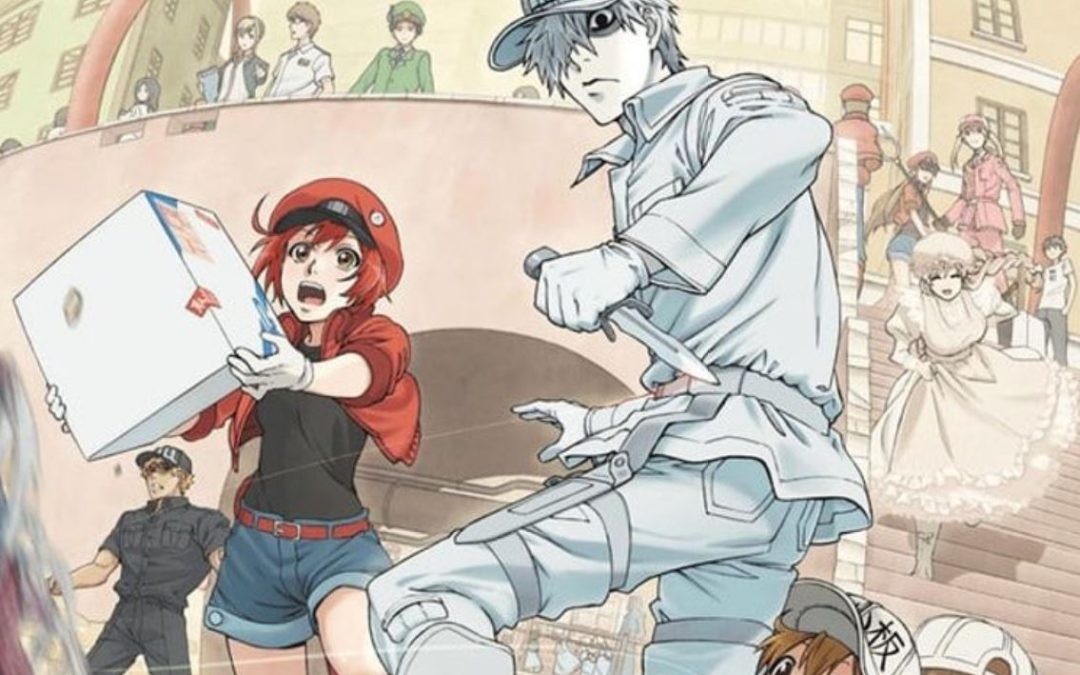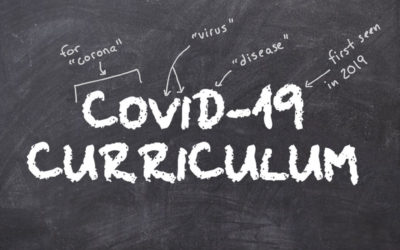Okay – we’re totally behind the curve here, but we should talk about Cells at Work. It showed up on Netflix last September and probably flew under the radar of a lot of the adult Netflix audience, but probably not its otaku fanbase. Apologies to said fanbase who are rolling their eyes right now, but a quick explanation of what it is…
Cells at Work was created by Akane Shimizu who both wrote and drew the manga version of the story that appeared in Monthly Shonen Sirius beginning in January 2015, with the anime series from David Production running in Japan from July to September of 2018. In the US, the original manga is available as a five-volume set from Kodansha, while the anime is streaming on Crunchyroll and since January, Netflix, and is also available for sale on iTunes and in the Microsoft Store. Season one is made up of 14 episodes, and season 2, based on the manga, Cells at Work: Code Black is due for release early next year. A theatrical version, Tokubetsu Jōei-ban “Hataraku Saibō!!” Saikyō no Teki, Futatabi. Karada no Naka wa “Chō” Ōsawagi! (Special Screening Edition: “Cells at Work!” The Return of the Strongest Enemy. A Huge Uproar Inside the Body’s “Bowels!”) is slated for release in early September, as well.
Yeah – it’s popular.
Here’s the official description of the story:
This is a story about you. A tale about the inside of your body…
According to a new study, the human body consists of approximately 37 trillion cells. These cells are hard at work every day within a world that is your body. From the oxygen-carrying Red Blood Cells to the bacteria-fighting White Blood Cells, get to know the unsung heroes and the drama that unfolds inside of you!
Simply put, Cells at Work is an action anime set inside the human body. The series stars are anthropomorphized cells, each with a job to do. Its primary characters are an Erythrocyte/Red Blood Cell (AE3803) and Neutrophil/White Blood Cell (U-1146) whose ties go back to their earliest days when U-1146 saved AE3803 from an invading bacterium.
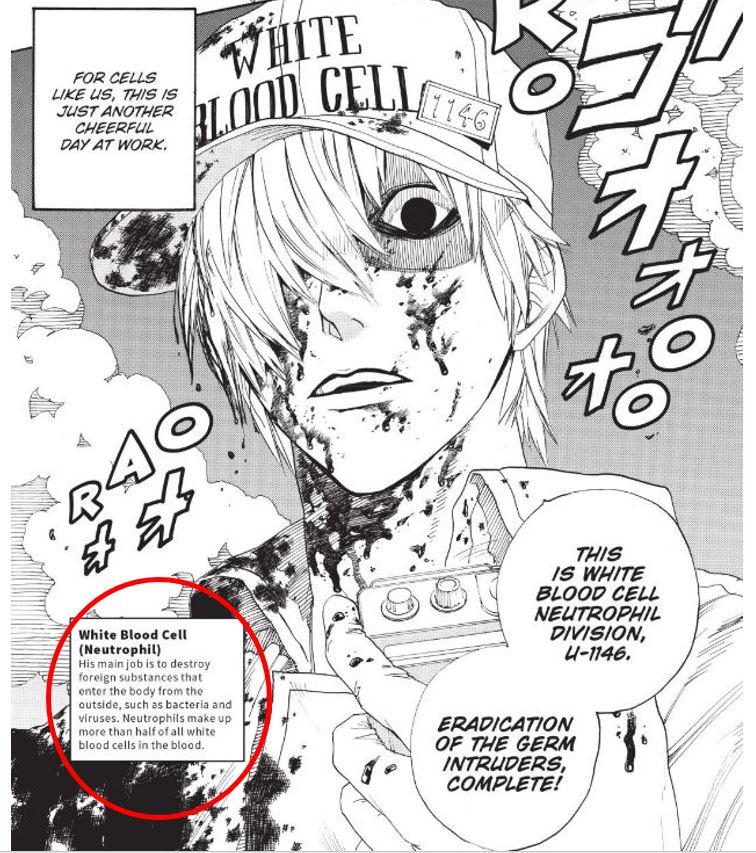
Introduction of White Blood Cell, U-1146 from Cells at Work manga, Vol 1. Note the description of what neutrophils are and do… (c) Akane Shimizu
Other characters in the cast are a who’s who of the human body: Killer T Cell (arrogant and bloodthirsty), Macrophage, Platelet, Helper T Cell, Regulatory T Cell, Naive T Cell, Effector T Cell, Memory Cell, Mast Cell, Cancer Cell and many more. The characterizations of each match pretty closely with what you thought the individual cells would act and sound…even if you never really thought about how cells inside a human body would act or sound. For example, Naive T Cell is a rookie who’s never seen any action, the platelets are small children who work together as a repair crew, and AE3803 is constantly carrying boxes (oxygen or carbon dioxide) around the various passageways, which are analogous to blood vessels and other tissues, organs and regions of the body.
Here’s an interactive that shows and describes the roles of the various cells that make up the cast. Think of Cells at Work as that episode of The Magic School Bus where they went inside Ralphie to watch his immune system work And re-done on the new series with Carlos). But aimed at an anime-savvy audience, and with a lot more blood and knives than Ms. Frizzle would have ever allowed on her bus.
The anime series effortlessly reaches a balance between entertaining and informing thanks to both the actions and exposition of the characters as well as the narration and on-screen text. The titles of the first season’s episodes read like the sections of an intro biology text:
- Pneumococcus
- Scrape Wound
- Influenza
- Food poisoning
- Cedar Pollen Allergy
- Erythroblasts and Myelocytes
- Cancer Cells
- Blood Circulation
- Thymocytes
- Staphylococcus aureus
- Heat Stress
- Hemorrhagic Shock (Part 1)
- Hemorrhagic Shock (Part 2)
- The Common Cold – special episode, currently streaming on Crunchyroll, but not on Netflix
Here’s a feel for it, via the trailer:
The series on Netflix and Crunchyroll is subtitled (“subbed”) rather than dubbed over with English-speaking actors providing the voices (“dubbed”).
And that’s just the anime. The manga available, either through local comic shops, bookstores, Amazon or digitally, at Comixology, consists of the original five volumes, as well as the second larger storyline (five volumes) that makes up the second season of the anime, Cells at Work: Code Black, Cells at Work: Baby!, Cells at Work: Bacteria!, Cells NOT at Work!, Cells at Work and Friends!, and Cells at Work: Platelets!
And there’s an awesome line of merch at Giant Microbes.
Yeah, but what about the science of Cells at Work?
It’s actually pretty good. And that’s without many qualifications. The cast list reads like a listing of all the proteins and cells in the human bloodstream, and the episode list is made up of topics that demonstrate the integration of how the components work together. For a general audience, or one just getting used to the concepts, it’s great.
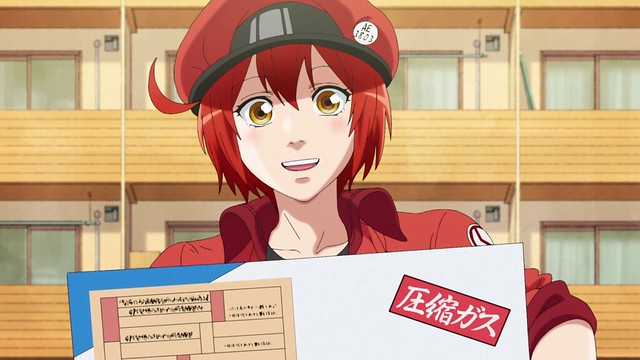
The series’ main character – Red Blood Cell, ready to delivery oxygen (c) Akane Shimizu, KODANSHA, Aniplex, davidproduction
Reviewing volume 1 of the manga version at Anime News Network and speaking of the educational and scientific content, Rebecca Silverman wrote:
“…it isn’t necessarily the most logical way to present the information, but it does give readers an understanding of how blood cells work within the body. If you look closely, you can see that the red blood cells reverse their jackets depending on if they’re carrying oxygen or carbon dioxide, while all of the various white and T cells wear variations on the same uniform. Platelets, the smallest of the cells, are drawn as children, which definitely gets the point across, and when red blood cells are carrying nutrients, they have baskets stuffed with food. Shimizu runs into a little more trouble with strictly scientific information, as there’s a lot of repetition in the text boxes and dialogue, which makes reading drag a little. On the other hand, repetition is good for remembering, so that may make it work better in an educational context.
Cells at Work! is far more entertaining than it ought to be. Both Red and White are likable characters and imagery such as a B cell with a fireman-style antibody sprayer or sneezes visualized as torpedoes (what kid doesn’t want to think that every time they sneeze a torpedo shoots out their nose?) help make the story exciting. Whether you have an interest in learning about the immune system or not, this is an enjoyable read. It’s the most fun you’ll have in biology lessons since that one kid figured out how to make the dead frog twitch on the dissecting table.”
The series has also found a large audience in China – normally a tough market for Japanese anime – where biology teachers have assigned it as classwork.
Given that the anime has been out and around since 2018, the science of the series has gotten a pretty thorough go-over by doctors who are also anime fans, as well as students, scientists, and more. In August of 2018, Jean, a third-year med student who majored in molecular biology and worked coordinating clinical trials told Crunchyroll, “I’ve been really struck by how accurate certain things are there’s a scene that jumps out at me which is of the platelet kids laying down a massive fibrin clot. Ask any medical student about the coagulation cascade. It’s probably one of the more annoying things to memorize leading up to boards, but the basic idea along with some key initiator molecules were all there in the scene!
“GP1B binding to Von Willebrand Factor, the addition of the coagulation factors to lay down the fibrin clot and the grand follow up of secondary hemostasis of everyone being brought together to keep the clot stable, it was pretty brilliant! Obviously, some details were missing (there are 13 coagulation factors) but the idea was conveyed very clearly and way closer to reality than I would’ve predicted out of an anime.”
Jean also praised the series depiction of the sequence leading up to T-cell activation – a difficult concept to understand as taught, normally, as well as how the series is structured like a biology course…beginning with the simpler concepts and then moving to bigger pictures, or, as we’ll see in Code Black, new systems and locations in the body.
If you want a larger feel for how the series stands up, here’s Dr. Ed Hope, an Emergency Medicine Doctor and Teaching Fellow from the UK explaining what he likes about the series as he watches it. No medical detail gets past him…
If you need a refresher/review, or a more in-depth look at the science of any particular episode, head over to Dr. James Ong’s fantastic blog, The Active Scientist. He’s got in-depth reviews of each episode, comparing the real science with that shown in the episode, as well as comparisons of real-world cells, bacteria and parasites with their anime versions.
But let’s go back a second – as Dr. Hope points out in his video, “the action sequences and the storytelling and the sound is so well done…really compelling.”
Yeah, let’s talk about that…
Science communication and using Cells at Work in a classroom
For my STEM teachers of any level…
What Dr. Hope said is super-important in communicating science and teaching STEM subjects – it’s really compelling and engaging. “Science as story” is a theme we play on a lot around here. Sure – that’s the always present biographies and real-life tales of the trials, travails, quirks, and fine-grain human nature of science and scientists, but also, this includes telling a story to make the science interesting. To make it compelling. To give students a sense of ownership – science shows up in something they already like, in this case, anime and manga.
I think what helps set Cells at Work apart in this regard is that while it’s made to be somewhat educational, it’s a story first. Cells at Work has far more factual information in it than an average cartoon, comic, movie, manga, or anime, but it’s not about that, exclusively. It’s about, well, primarily, it’s about AE3808 and U-1146. The science – the facts of who the characters are and what they do, and for example, the details about the parasite that invades from the stomach after the person has eaten raw fish in episode 4 are all there, but not pushed that hard on the viewer. That’s what makes it work.
And that’s what can make it work in a STEM class…or a science communication class for that matter. We have a part of our brain that hungers for story. For a description of events related to an audience that has a beginning, a middle, and an end.
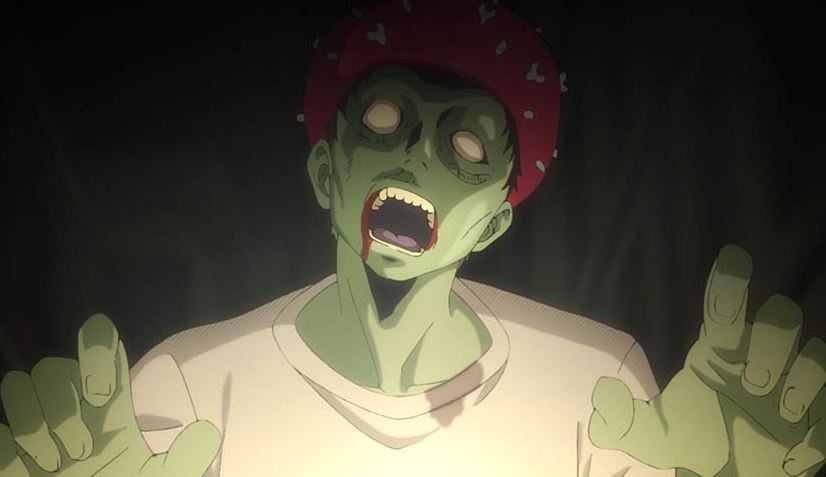
Episode 3 – influenza attacks the body, producing zombie cells everywhere! (c) Akane Shimizu, KODANSHA, Aniplex, davidproduction
As Jean said in the Crunchyroll interview – the anime version of cell types and their interactions when portrayed as social and mission-based events make more sense and are a lot more compelling than just the facts – no matter how inspired the explanations.
That’s a lot of words that just say it’s engaging for students. It hits them where they live. It’s the least-educational looking thing that many of them will see, but yet it delivers a good overview of body systems and basic biology, anatomy, and physiology. And showing that you, as their teacher, digs it too, it builds that relationship between you and your students, giving them a chance to see you as a person, as well as their teacher. Look at it from your students’ eyes for a minute – they’re coming into a new class, a new year. Maybe in-person, but probably online. What if one of their first assignments is something that asks them to watch or read Cells at Work, episode 1? How would you feel about that new class – and that new teacher if you were a student who encountered that?
So how do you make this work for students?
There aren’t many resources created by teachers showing up in the wild – which is good, you’ll see. In regards to making and using your own, I’ll repeat what we say at our presentations – or, honestly, it’s what Batman says on a slide: “You don’t own me.”
As we advise teachers at our workshops…keep it in your classroom. Don’t let it sneak online, encourage your colleagues who want to borrow it to craft their own, and don’t put it on Teachers Pay Teachers (it would be taken down for violating their guidelines anyway).
To just walk down the TpT road for a minute – if you were to make a sheet with the name or any of the images and post it for sale, no amount of Fair Use Doctrine citing, or “images are property of the respective copyright holders” will keep you from getting a Cease and Desist letter once Kodansha spots it. And no lawyer would suggest that you fight it.
Three things are important here if you make a Cells at Work worksheet and sell it on TpT – 1) you are making money off of someone else’s copyright, 2) using copyrighted material goes against TpT’s rules, and 3) to keep a copyright alive, the copyright must be protected and defended by the owner. The presence of a Cells at Work worksheet on TpT may go unnoticed for a little while, but it won’t stay that way forever. It’s not if Kodansha finds out, but when. Even sharing it online – you’re distributing copyrighted material to which you have no legal claim.
IN this regard, there are official images available from the Japanese publisher of the manga, here. According to the site (Google translate is a wonderful thing), you can download and use the images of the cells/characters for free – as long as it is for educational purposes and not used commercially.
Don’t get burned. Okay? Okay.
That said, as a resource, Cells at Work is rock solid for the delivery of concepts and relationships that are always going to sound foreign to students the first time (and maybe second, third and fourth) they hear them. Be totally aware though – some finer details may get left out in Cells at Work, depending on the system and the role that the specific factor or cells play. For example – there’s generally only one type of Platelet shown, and the job they do is represented in a rather basic manner, with only a few text/narrator explanations for clarity.
And also – skip out on any dubbed version. The characters speak very quickly to catch all the dialogue for educational benefit. The subbed version has the names of the cells written out and viewers have to read along to understand what’s happening. Having students see and read the words a couple of times – they’ll probably want to watch it at least twice – it’s that good – which is a benefit for literacy standards.
Using Cells at Work as a resource for your biology, physiology, or anatomy class – the doors are wide open. Watch out, though – some of it the expanded stories in the manga could be seen as pushing hard on the PG-ish rating the anime would have, given that it’s a story and animated characters explaining say, the reproductive system, rather than text and diagrams. It’s the same information, but the delivery could cause issues with sensitive students or parents.
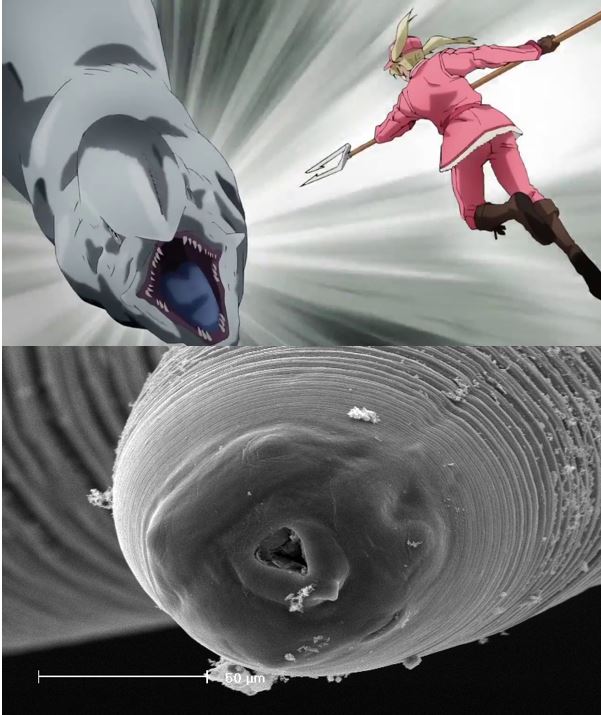
Above, Eosinophil attacks the parasitic worm, Anisakiasis. Below, what a real Anisakiasis worm looks like. Top image: (c) Akane Shimizu, KODANSHA, Aniplex, davidproduction
Just to scratch the surface of what could be done in a classroom, the anime or manga can be used to introduce the concepts from the very start to soften the ground and make understanding and acceptance of the concepts a lot easier. The characters could be compared and contrasted to their real-world counterparts, to the point of comparing side-by-side images of each and critiquing their respective artistic representation/interpretations.
The sequence of events shown in the anime can be translated to a more fleshed-out form, including more standard-level detail. Individual pathogens and parasites could be researched.
And vocab, vocab, vocab! Having a character for so many cells will help the learning and retention of a vast list of terms. And don’t forget to include the narration or text boxes that explain the background and concepts.
Expanding from the original work, how could the Cells at Work approach be used with other systems? There are a lot of volumes and the manga has covered a lot of the body, but could your students make new characters and write new adventures in different parts of the body? Making sure students understand sequence – the cause-and-effect nature of scientific concepts is something we all need to focus on and explaining it as a comic, or in this case, as manga, works tremendously well in that regard. Just remember – if you assign students to do a Cells at Work version of a system (making up characters and locations as they go…), you’re going to have some that will make it as a traditional manga – which reads from right to left, and you start at what you would normally think of as the back of the book, instead of the front. Don’t take points off because you think they did it backward.
But please check it out – you’ll be hooked from the first episode, and if you’re teaching life science, Cells at Work will probably be making it into your plans for the coming year.


